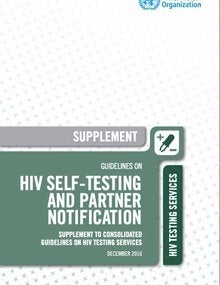In that first edition of the guidelines, WHO synthesized the existing guidance on HIV testing services (HTS) and issued a new recommendation to support trained lay providers to deliver HTS using rapid diagnostic tests (RDTs). In addition, the guidelines emphasized the need for strategic approaches to deliver HTS. In particular, they highlighted the potential of HIV self-testing (HIVST) to increase HTS access, especially among men, key populations1 and young people. They also highlighted the need to improve the uptake of couples and partner testing services, including by offering HTS to the partners of people with HIV (1). Moreover, the guidelines noted that there was a growing unregulated market for HIVST in low- and middle-income settings, where products of unknown quality were often being used. Since the release of the 2015 guidelines, a growing number of countries have recognized the need to support HIVST in a more regulated way and to use HIV RDTs for self-testing that are approved by the relevant regulatory authority, or following results of an international regulatory review.
|

